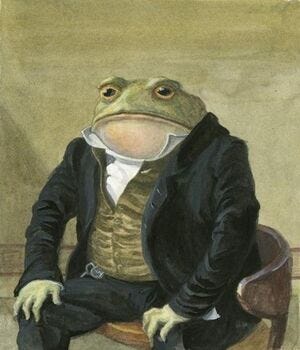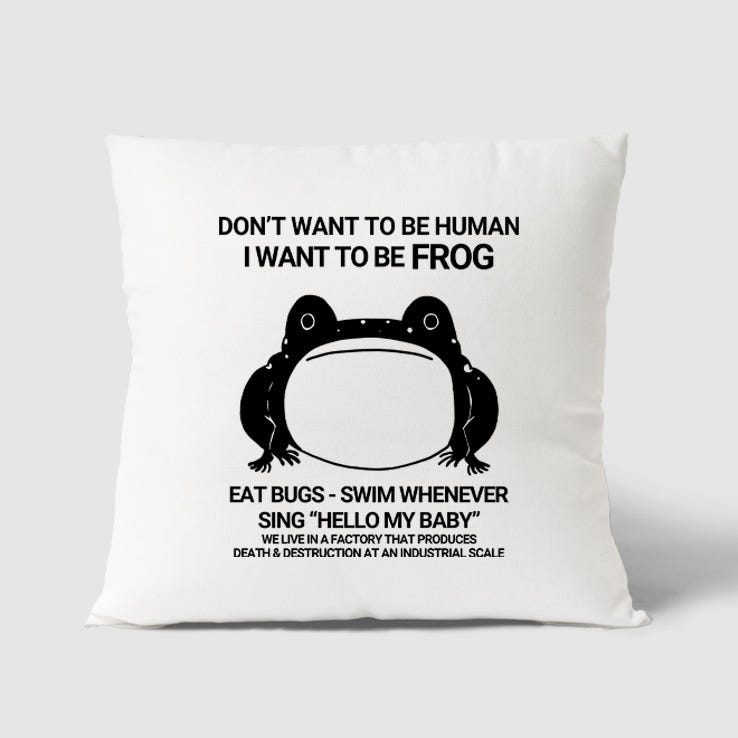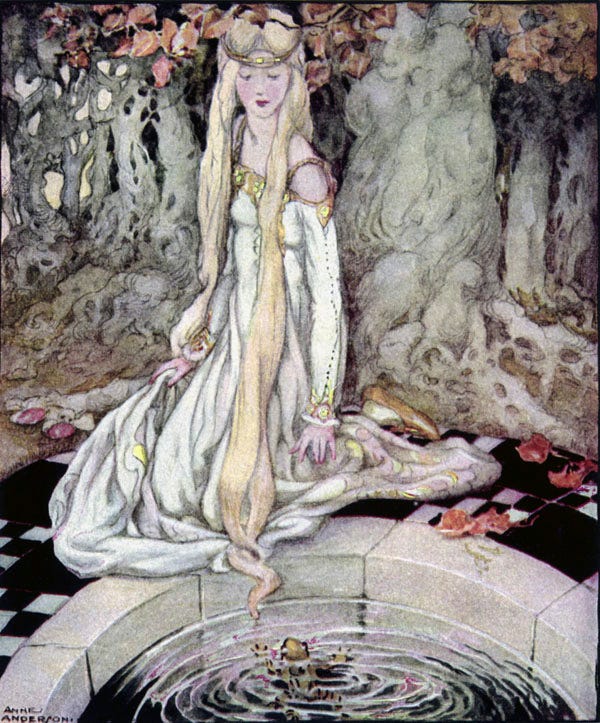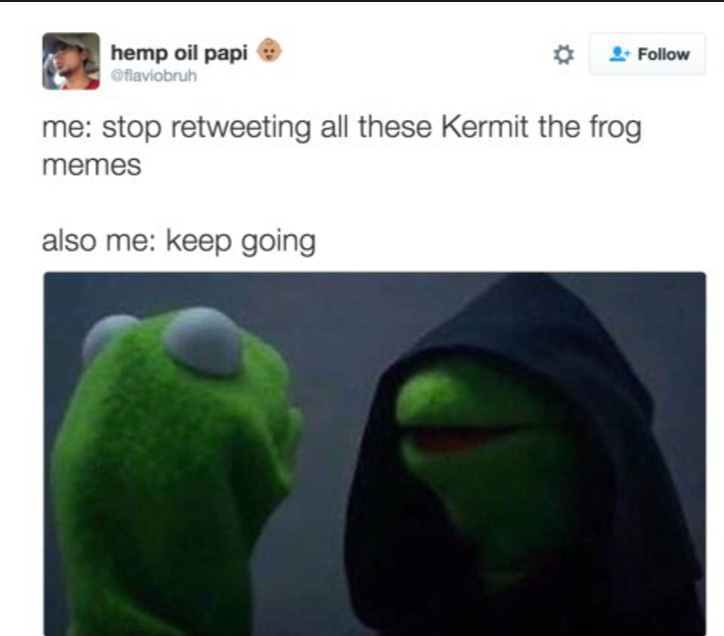I think it’s time to accept one of life’s cold, hard facts: the internet is full of frogs.
Everywhere I look, it’s Unhinged Frog memes here and Frog Mages there. There are about a billion funny cartoons of innocuous-looking frogs saying ominous things about death, suffering, and man-made horrors beyond our comprehension.
One might speculate the reason for this is that frogs look kind of silly. With their bulbous eyes and blank stares, they give off a sort of aloof vibe that contrasts well with extremely articulate observations about living inside of the nihilistic 21st Century Death Machine of industrialism and materialism where the only thing that exists is power and those who are willing to use it.
Looking back at the classic German fairy tale, The Frog Prince, however, we see that frogs have always been at the center of uncertain transition. And if there is one thing I think we can all admit, we are currently experiencing such a time.
Nothing seems stable right now. Just a few years ago, our world was upended by a virus that shifted daily activities overnight, deepened ideological divides, and shined a bright light on just how fragile our interconnected world has become.
Throw in the advent of AI, the ever-encroaching shadow of tyranny and its inevitable anarchic reaction, and the threat of nuclear war and suddenly the arrival of tomorrow seems a lot less certain. The solid ground of our lives is slowly being consumed by the black bog water of an uncertain future.
Between the Surf and the Turf
All across time and cultures, there is this consistent through line of land being equated with order and water being equated with chaos and potentiality. Frogs, being an amphibious creature, exist as a symbolic mediator between these two polarities. They straddle order and chaos and live in that murky in-between state known as the bog.
If we take a look at the tale of The Frog Prince, we see that it is only the frog who can dive down deep and retrieve the golden ball from the bottom of the well for the princess. In the story, the princess agrees to kiss the frog if he helps her retrieve the golden ball and in other older versions, requires her to eat with him at the tale and sleep with him in her bed.
The Frog Prince by Anne Anderson
The princess is not so keen on making deals with frogs however and would very much like to use him to get what she wants and then swiftly cast him aside without holding up her end of the bargain.
And so we can easily see ourselves here as the princess, hesitant to enter into pacts with things we don’t understand. Afraid to leave solid ground and venture out into the shifting muck of the swamp.
But if we want to find our golden ball, then the answer will have to come from the margins. I don’t know exactly what that golden ball is—I don’t even know what a remedy to our current ailments might begin to look like—but whatever it is, it is certain to come in a form and from a source we don’t expect.
Because everything orderly is the stuff of the known. If we knew the exact answer to fix our world and how to implement it, then we already would have done so. So it stands to reason that the way forward cuts through some dodgy territory where we will be forced to discern friend from foe and question our most basic assumptions about people and the nature of reality. We may even have to shake hands with a few devils to get where we need to go.
It’s been noted that some old fairy tales regard symbols of the strange as “bad,” like the old witch at the edge of the forest that eats children, while other cultures view these margin-dwellers as “good” like ancient Chinese dragons being signs of blessing.
Both of these representations are true. Because for something to exist in an in-between (or symbolically amphibious state) they must contain both good and bad at the same time. As I’ve said before, when you walk out into the unknown, sometimes you find God and sometimes you find the Devil.
So when we first see the frog in The Frog Prince, we’re not quite sure what to make of him. After all, he’s holding this young girl’s golden ball hostage and using it as a means to bargain his way into bed with her. Pretty suspect, if you ask me.
But what happens if the princess says no? No golden ball.
The Golden Ball
The Frog Prince and the Golden Ball by Edmund Dulac
The golden ball is no trivial detail. The golden ball is the entire heart of the story. We see this idea mirrored and enunciated when the frog finally undergoes his transformation and is returned to his higher, more princely state. In some of the tales, the story includes one of the prince’s loyal servants. And through the prince’s sojourn as a slimy, crawly guy; we are told that the servant has three iron bands around his heart.
In classic fairy tales, iron is used as a symbol of masculine imprisonment, (its opposite being glass or crystal which imprisons the feminine.) We’re told that the servant placed the bands around his heart to keep from drowning in despair and when the prince finally returns to rightful state, the bands break with a loud cracking sound.
From How the Grinch Stole Christmas! Photo Credit: MGM Studios
This is the image of the golden ball. It’s not just some play thing. It’s the whole redemption of human existence. It’s the wrong being made right again and the captive being set free. It’s the return of the king motif in The Lord of the Rings and Robin Hood. It’s the golden egg that’s laid by the goose. It’s the ability to spin straw into gold.
Iron Bands
So now we’re forced to ask ourselves some important questions:
What iron bands have we put around our own hearts and what would it mean to have them broken?
In what part of the chaotic waters has the golden ball rolled into?
And what frog-like characters among us hold the key to our ultimate salvation?
These are difficult questions to answer. And we’d do well to remember that while the frog turns into a prince, Rumpelstiltskin undergoes no-such transformation. And while the frog-like Gollum of Tolkien’s legendarium has both a good and a bad side, it’s the bad side that comes out on top (but all for the good.)
There is still danger lurking in the image of the strange, however tempered by blessing it may seem. And it might require us to be at our most cunning to retrieve the golden standard.
We should also remember that the iron bands on our hearts are there for a reason. Sometimes the bars of a cage are used to keep things imprisoned and sometimes they’re there as a form of protection.
Take them off too early and the heart is consumed.
So it’s quite a state we find ourselves in. We’re paranoid, but not without reason. We’ve seen the glow of oncoming dawn but there are still many miles to walk and a not insignificant amount of darkness to walk them in. The reality is that there is a golden ball out there. There is a better way of doing things and getting there might be scary or even dangerous.
But for now, it might do to just scroll our newsfeeds and harvest a bountiful crop of frog memes. Because in each goofy little image is a spark of something, you just have to see past the wet and scaly outside.










Rev 16:13 - And I saw three unclean spirits LIKE FROGS come out of the mouth of the dragon, and out of the mouth of the beast, and out of the mouth of the false prophet.
(and obviously there's the 2nd plague in exodus 8, "a mockery of heket" which results in Pharoah's heart being hardened)